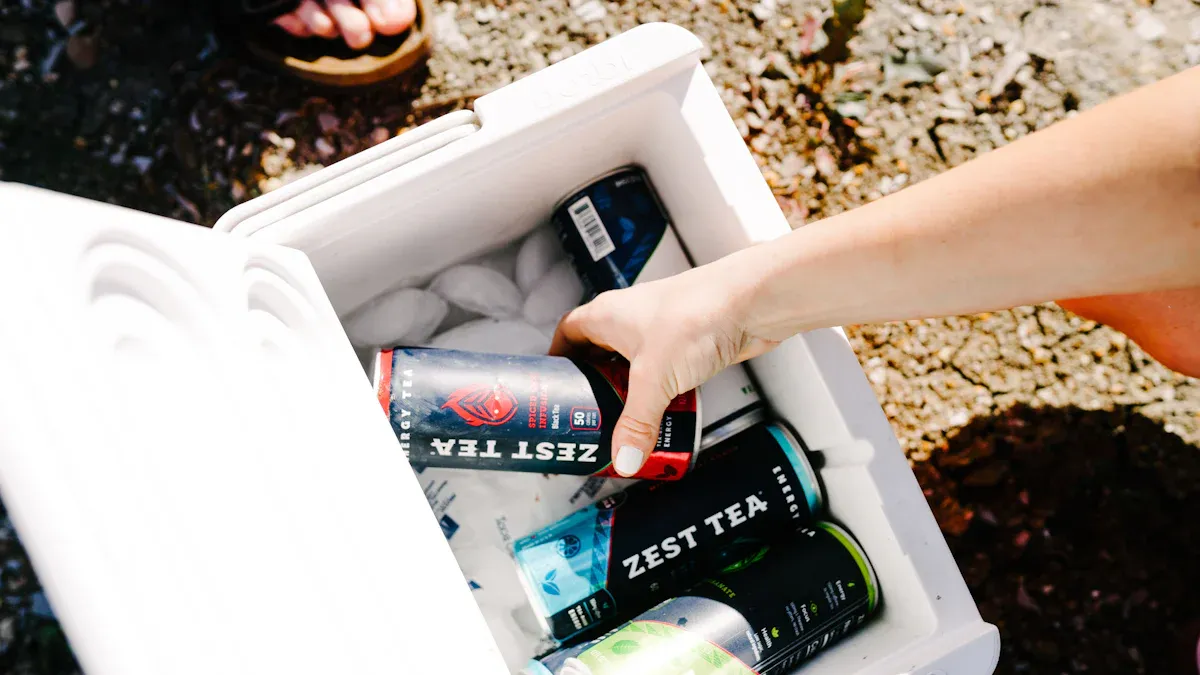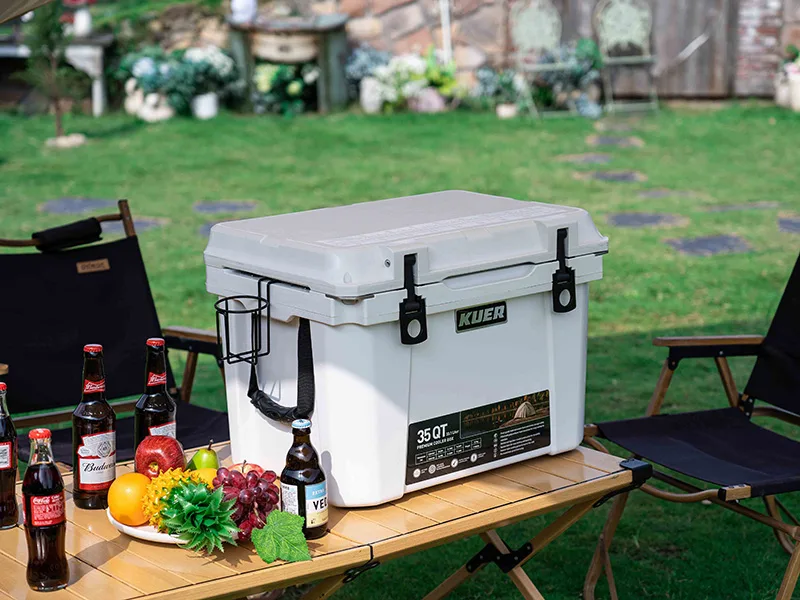
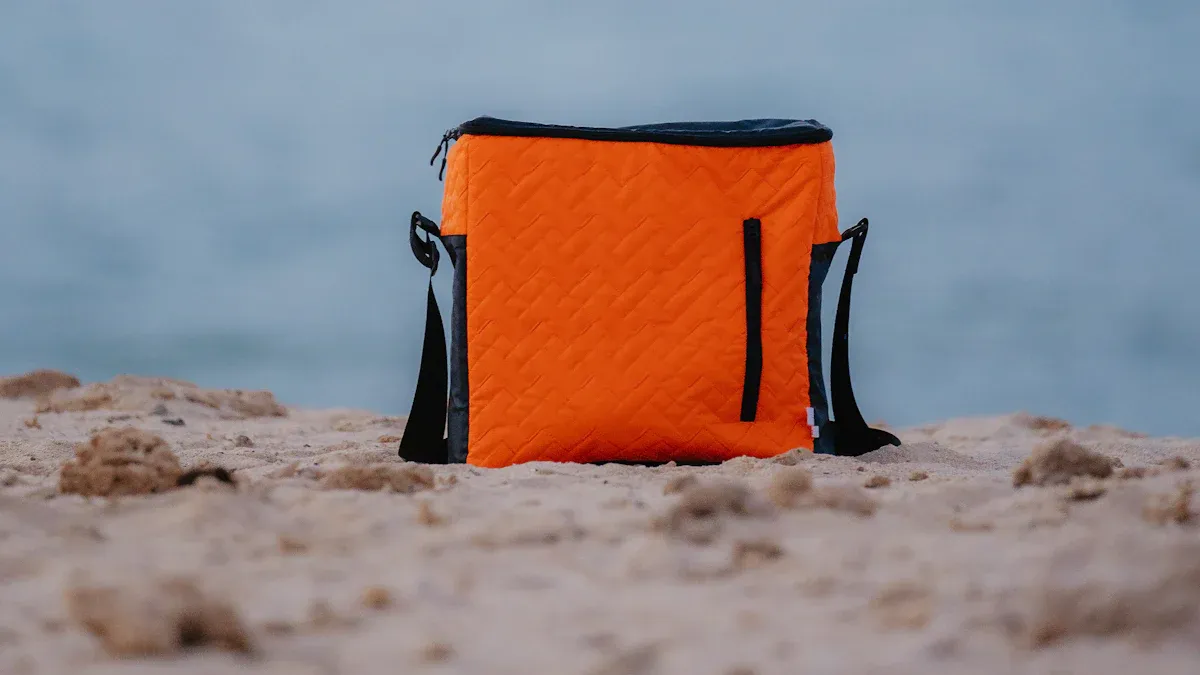
When you’re heading out for a camping adventure, having the right outdoor ice chest cooler can make all the difference. A lightweight, durable, and highly portable duffel cooler bag ensures your food and drinks stay fresh while being easy to carry across rugged terrains. Did you know the global camping cooler market was valued at $893.7 million in 2022? This shows how important these coolers are for outdoor enthusiasts like you. Compact options, especially under 25 quarts, are becoming increasingly popular because they’re easy to handle and perfect for shorter trips.
Kuer, one of the leading cooler box manufacturers will provide you with a variety of cooler solutions.
Portability is key for enjoying your time outdoors. Backpack-style coolers, for example, are highly portable and waterproof, making them ideal for long hikes. Whether you’re trekking through the woods or setting up camp by a lake, a waterproof cooler bag keeps your supplies safe from unexpected splashes or rain. Plus, advanced insulation ensures your drinks stay cold and your meals fresh, no matter how far you roam. Choosing the right cooler bag tailored to your needs can transform your camping experience.
Top Picks for Lightweight and Durable Cooler Travel Bags
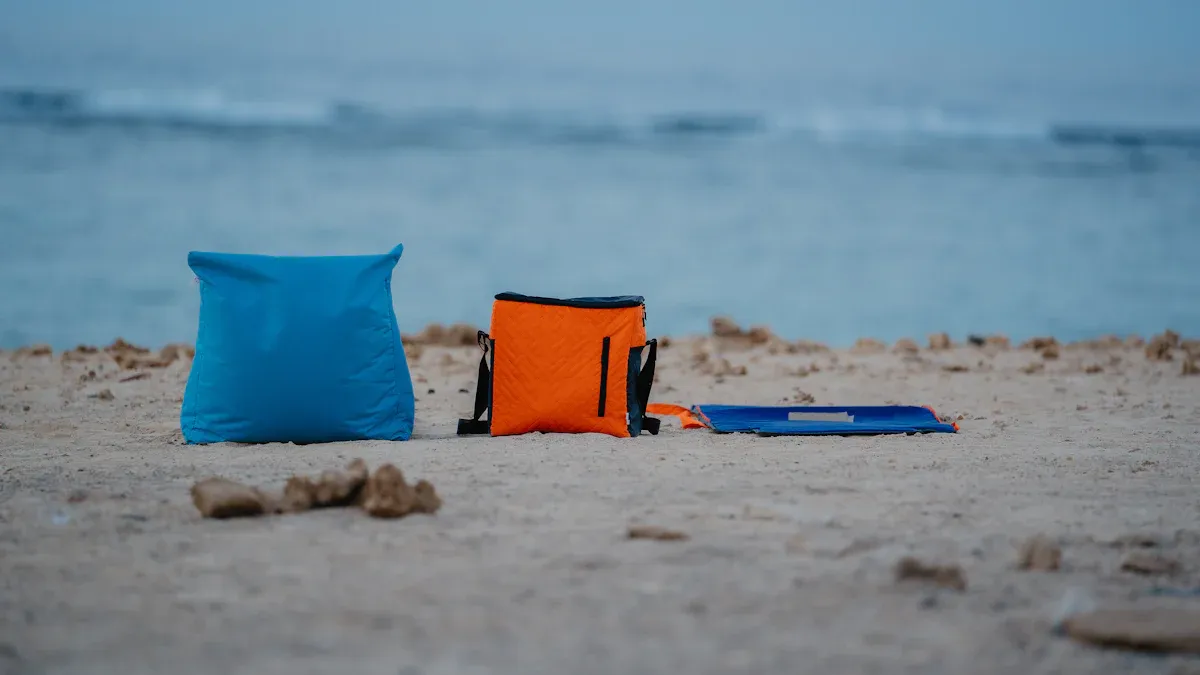
Best Overall Soft Cooler
When it comes to the best overall soft cooler, the Yeti Hopper Flip 18 stands out as a top choice. Its heavy-duty construction and wear-resistant outer fabric make it a reliable companion for any adventure. You’ll appreciate its sturdy zippers and durable components, which ensure long-lasting performance even in rugged conditions. This cooler excels in insulation, keeping your items cold for extended periods, making it perfect for both short and long trips.
Another excellent option is the RTIC Insulated Soft Cooler Bag, which combines exceptional ice retention with a sleek design. Priced at $129, it offers great value for its performance. Whether you’re heading out for a day hike or a weekend camping trip, this cooler travel bag delivers on both durability and portability.
If you’re looking for the best soft cooler on a budget, the Coleman Chiller Soft-Sided Portable Cooler is a fantastic pick. At just $40, it’s affordable yet practical, offering decent insulation and lightweight portability. It’s ideal for casual outings or quick day trips where you need a reliable cooler without breaking the bank.
Tip: Soft coolers are great for their lightweight design and ease of transport. They’re perfect for those who prioritize portability and convenience.
Best Insulated Cooler Bags
Insulation is key when choosing a cooler bag, and the best insulated cooler bags excel in keeping your food and drinks fresh. Materials like closed-cell foam and high-density polyethylene are commonly used to enhance insulation performance. For example, closed-cell foam can keep items cool for up to six hours, making it ideal for short trips. On the other hand, high-density polyethylene provides exceptional insulation for all-day adventures, ensuring your supplies stay cold for over eight hours.
Here’s a quick comparison of insulation materials and their performance:
| Material | Insulation Performance | Best Use Case |
|---|---|---|
| Closed-cell foam | Keeps items cool for up to 6 hours | Short trips up to 6 hours |
| High-density polyethylene | Exceptional insulation for extended periods | All day (8+ hours) |
| Reflectix | Reflects heat away, maintains cold for freezer packs | Best for freezer packs |
| Recycled polyester | Good insulation, eco-friendly | Eco-friendly options |
| Cotton-based insulation | Biodegradable, renewable | Eco-friendly options |
For versatility, the HydroFlask Day Escape Soft Backpack Cooler is a standout. Priced at $199, it’s designed for various activities, from hiking to picnics. Its insulation performance ensures your items stay cold throughout the day, making it one of the best cooler bags for day trips.
Best Backpack Coolers
Backpack coolers combine portability and functionality, making them a favorite among outdoor enthusiasts. The Eddie Bauer Recycled Bygone Backpack Cooler is a lightweight option, weighing just 635 grams (1.4 pounds). It’s perfect for those who value portability and eco-friendly materials. If you need something more robust, the ICEMULE BOSS offers a larger capacity and weighs 3,402 grams (7.5 pounds). Despite its heavier weight, it’s still easier to carry than most hard coolers.
Backpack coolers are generally lighter than hard-sided alternatives, thanks to their compact design and materials. They’re also waterproof, ensuring your supplies stay dry even in wet conditions. Whether you’re hiking, camping, or enjoying a beach day, these coolers provide the perfect balance of convenience and performance.
Here’s a quick look at some top-rated cooler bags, including backpack options:
| Rank | Cooler Bag | Price | Features |
|---|---|---|---|
| 1 | RTIC Insulated Soft Cooler Bag | $129 | Best Overall, excellent ice retention |
| 2 | Coleman Chiller Soft-Sided Portable Cooler | $40 | Best Budget, affordable and practical |
| 3 | HydroFlask Day Escape Soft Backpack Cooler | $199 | Most Versatile, great for various activities |
| 4 | RTIC Outdoors Everyday Insulated Tote Bag | $50 | Best Tote, convenient for carrying |
| 5 | Nook Theory Insulated Grocery Bag | $28 | Best for Groceries, ideal for shopping |
| 6 | Corkcicle Beverage Bucket Bag | $146 | Best for Picnics, stylish and functional |
| 7 | Tirrinia 2-Bottle Wine Carrier | $21 | Best for Wine, perfect for transporting wine bottles |
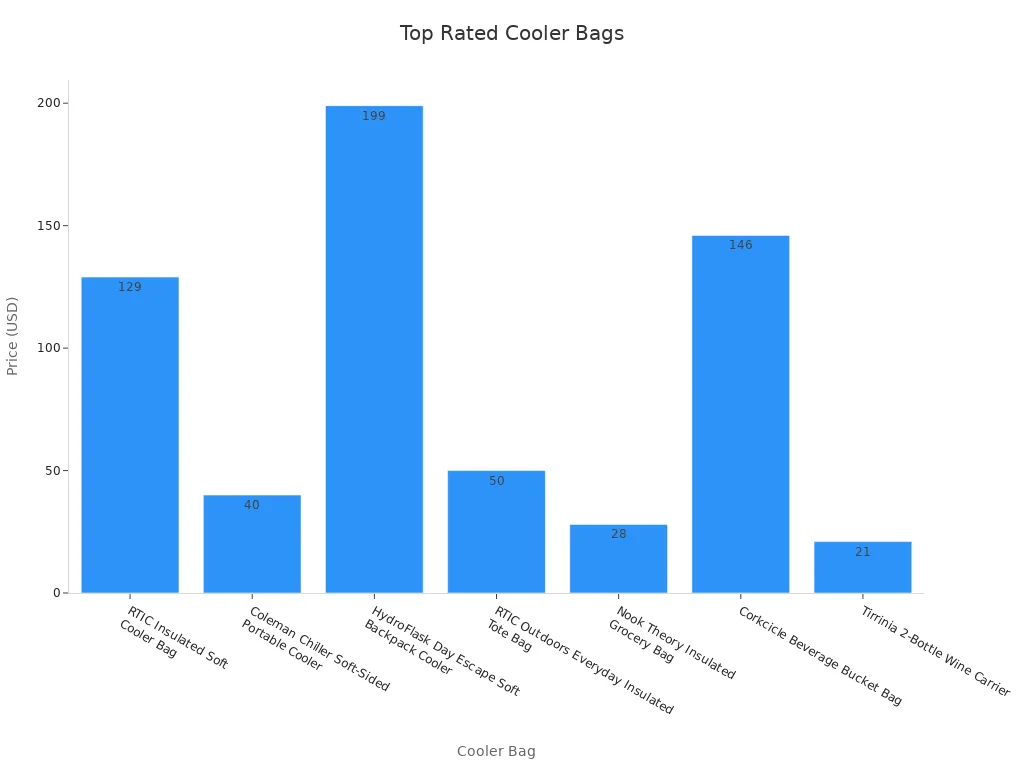
Note: Backpack coolers are ideal for hands-free carrying, making them a great choice for active outdoor adventures.
Best Soft Coolers for Solo Camping
When you’re heading out on a solo camping trip, you need a cooler that’s compact, lightweight, and efficient. The best soft coolers for solo camping combine portability, insulation, and waterproof features to ensure your food and drinks stay fresh without weighing you down. These coolers are perfect for short trips where you want to keep things simple yet effective.
Soft coolers like the YETI Flip 18 and AO Coolers Original Soft Cooler are excellent choices. They use advanced insulation materials, such as closed-cell foam, to maintain cold temperatures even in varying weather conditions. This feature is crucial when you’re camping alone and need reliable performance. Here’s a quick comparison of how some top-rated soft coolers perform over time:
| Cooler Model | Temp after 16 hrs. | Temp after 24 hrs. | Temp after 40 hrs. |
|---|---|---|---|
| YETI Flip 18 | 32°F | 32°F | 45°F |
| AO Coolers Original Soft Cooler | 32°F | 34°F | 54°F |
| Hydro Flask 20 L Day Escape Soft Cooler | 32°F | 34°F | 46°F |
| Engel HD30 Heavy-Duty Soft Sided Cooler | 32°F | 32°F | 51°F |
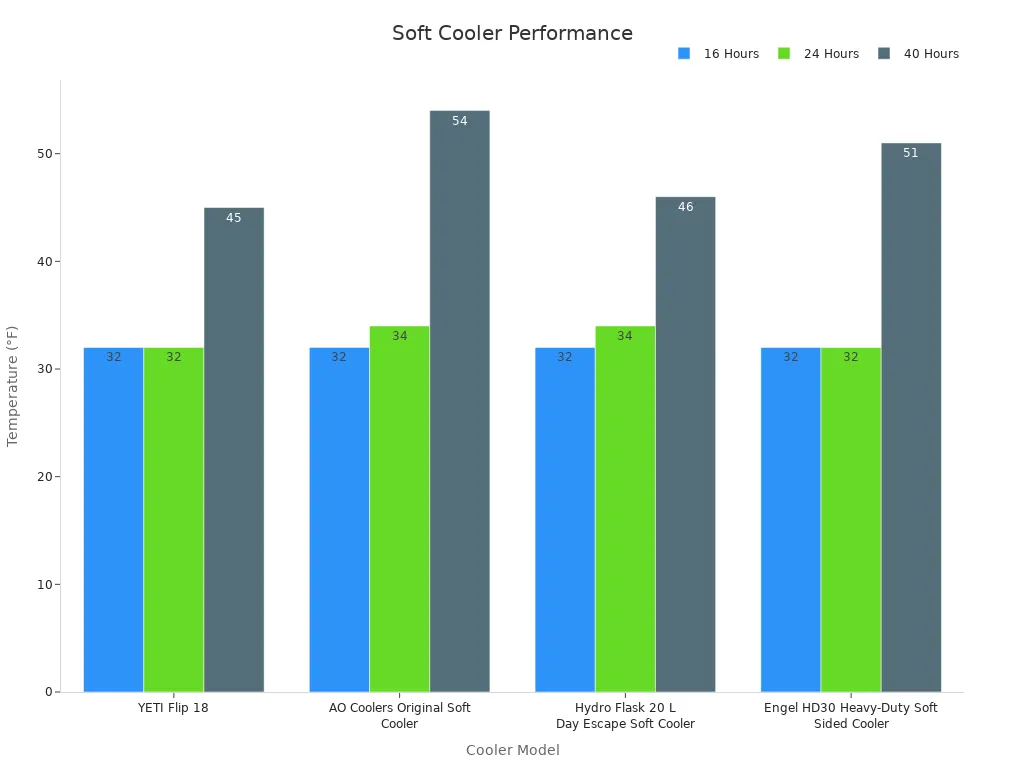
These coolers are not only efficient but also highly portable. For example, the Hydro Flask 20 L Day Escape Soft Cooler weighs just 3.1 pounds, making it easy to carry on your back or in your hand. Its waterproof design ensures your supplies stay dry, even if you encounter unexpected rain or splashes. Similarly, the Engel HD30 Heavy-Duty Soft Sided Cooler offers a rugged build and excellent insulation, making it a reliable choice for solo adventurers.
Tip: When choosing a soft cooler for solo camping, prioritize portability and insulation. Look for lightweight options with waterproof materials to make your trip hassle-free.
Best Large Capacity Cooler for Group Camping
Group camping trips require a cooler that can handle a large volume of food and drinks while maintaining optimal temperatures for several days. The best large capacity coolers are designed with durability, insulation, and usability in mind, ensuring they meet the demands of group outings.
One standout option is the YETI Tundra 65, which features thick walls filled with pressure-injected polyurethane foam. This design enhances insulation, allowing ice to last up to 7 days under optimal conditions. Durable components like T-Rex Lid Latches and the NeverFail Hinge System ensure the cooler can withstand heavy use, making it perfect for group camping.
Here are some key features that make large capacity coolers ideal for group trips:
- Thick, insulated walls for extended ice retention.
- Spacious interiors that can hold food and drinks for multiple people.
- Durable construction to handle rough outdoor conditions.
- Waterproof seals to prevent leaks and keep contents dry.
Another excellent choice is the RTIC 65 QT Hard Cooler, which offers similar insulation performance and durability at a more budget-friendly price. Its large capacity makes it suitable for storing everything from beverages to perishable food items. Plus, its ergonomic handles make it easier to transport, even when fully loaded.
Note: Large capacity coolers are essential for group camping trips. They ensure everyone has access to fresh food and cold drinks, even on extended adventures.
Key Features to Look For
Weight and Portability
When you’re out camping, the weight and portability of your cooler can make or break your experience. If you’re hiking to a remote campsite, a lightweight cooler is essential. On the other hand, if you’re driving to your destination, weight might not matter as much. The key is to match your cooler to your camping style.
Lightweight coolers like the Coleman Chiller 28-Can (weighing just 1.1 lbs) and the Arctic Zone Titan 24 Can (1.5 lbs) are perfect for those who need something easy to carry. These models come with features like padded shoulder straps and grab handles, making them highly portable. Here’s a quick comparison of some popular options:
| Cooler Model | Weight (lbs) | Portability Features |
|---|---|---|
| Pelican Dayventure Backpack Cooler | 9.3 | Heavy, less portable |
| Coleman Chiller 28-Can | 1.1 | Lightweight, easy to carry |
| Arctic Zone Titan 24 Can | 1.5 | Lightweight, easy to carry |
Tip: Look for coolers with additional pockets for storing small items like utensils or napkins. These extra compartments can make your trips more organized.
Interestingly, lighter coolers often come with higher portability ratings. This trend reflects their enhanced mobility, which is why they tend to be more expensive. If you’re planning long hikes or need a hands-free option, consider a backpack-style cooler. These are not only waterproof but also designed for comfort during extended use.
Durability and Material Quality
Durability is a must-have feature for any cooler travel bag. Whether you’re camping in the woods or spending a weekend at the beach, your cooler needs to withstand the elements. High-quality materials like tough polyester exteriors and closed-cell foam insulation ensure your cooler lasts for years.
Some cooler bags have been rigorously tested to prove their durability. For example:
- The Urban Peak 24 Can Cooler Bag held ice for about 45 hours.
- The Arctic Zone 3 Day Titan Cooler maintained ice for nearly 48 hours, even in extreme heat.
- The Coleman 36-Hour Marine Cooler kept ice for 40 hours, living up to its promise.
- The Prudhoe Bay Skipper retained ice for over 24 hours before starting to melt.
Manufacturers also test coolers through real-world scenarios. Over 84 hours of testing, cooler bags were subjected to activities like beach trips and camping. Long-term tests lasting six months evaluated their ability to keep items cold, resist leaks, and maintain structural integrity. Features like waterproof zippers and welded seams further enhance durability, ensuring your cooler can handle rough conditions.
Note: If you’re looking for a cooler that can handle heavy use, choose one with reinforced stitching and a sturdy base. These features prevent wear and tear over time.
Insulation Performance
Insulation is the heart of any cooler. It determines how long your food and drinks stay cold, which is crucial for camping trips. The best insulation materials, like closed-cell foam and pressure-injected polyurethane, provide excellent insulation by minimizing heat transfer.
Here’s a look at how some top-rated coolers perform in terms of ice retention and temperature control:
| Cooler Model | Ice Retention (Days) | Interior Temperature at 48 Hours (°F) |
|---|---|---|
| YETI Tundra 45 | 10 | 27.3 |
| Orca 40 | 10 | 27.8 |
| RTIC 45 | 8 | 29.2 |
| RTIC Ultra-Light | 8 | 31.2 |
| Igloo ECOCOOL | 10 | 34.6 |
| RovR RollR 45 | 6 | N/A |
| Coleman 316 | 10 | N/A |
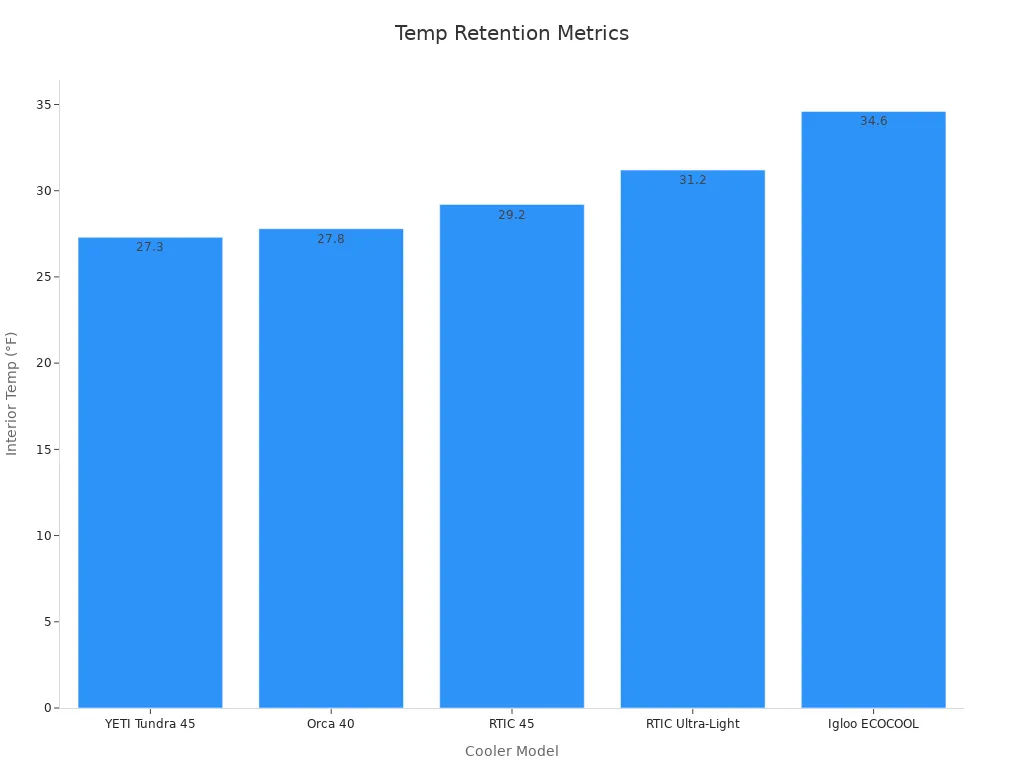
Coolers like the YETI Tundra 45 and Orca 40 excel in ice retention, keeping items cold for up to 10 days. This makes them ideal for extended camping trips. If you’re looking for good insulation performance at a lower price, the RTIC Ultra-Light offers solid results with an interior temperature of 31.2°F after 48 hours.
Tip: For the best insulation, pre-chill your cooler before packing it. This simple step can significantly improve its performance.
When choosing a cooler, focus on insulation performance that matches your needs. For short trips, a cooler with 6-8 hours of ice retention might suffice. For longer adventures, invest in a model with multi-day ice retention to keep your supplies fresh.
Capacity and Size Options
Choosing the right size and capacity for your cooler can make or break your camping experience. Whether you’re heading out for a solo weekend getaway or a week-long group adventure, the size of your cooler should match your needs. Here are a few factors to consider when deciding on the perfect cooler:
- Duration of Your Trip: Longer trips demand coolers with larger capacities and better ice retention. For example, a 65-quart cooler can hold enough food and drinks for a group camping trip lasting several days. On the other hand, a 20-quart cooler is ideal for short solo trips.
- Type of Camping: Are you car camping, backpacking, or setting up a base camp? Car camping allows you to bring larger, heavier coolers since you don’t need to carry them far. Backpacking, however, requires lightweight and portable options like soft-sided cooler bags.
- Capacity Needs: Think about how much food and drink you’ll need. A general rule of thumb is to allocate about 1 quart per person per meal. For example, a 25-quart cooler can hold enough for a small family on a day trip, while a 100-quart cooler is better suited for large groups.
- Portability: If you’ll be moving your cooler frequently, look for options with wheels or ergonomic handles. Wheeled coolers are great for flat terrains, while backpack-style coolers are perfect for rugged trails.
- Extra Features: Some coolers come with dividers, cup holders, or even built-in bottle openers. These features can make your camping experience more convenient and enjoyable.
For group camping, large capacity coolers like the YETI Tundra 65 or RTIC 65 QT Hard Cooler are excellent choices. They offer spacious interiors and superior insulation, keeping your supplies fresh for days. If you’re camping solo or with a small group, a compact cooler like the YETI Hopper Flip 18 provides just the right amount of space without being cumbersome.
Tip: Always consider the weight of a fully loaded cooler. A large capacity cooler might seem appealing, but it can become challenging to transport when packed with ice and supplies.
Additional Features (e.g., straps, compartments, cleaning ease)
The best cooler travel bags go beyond just keeping your items cold. They come packed with features that enhance usability, durability, and convenience. Here’s what to look for:
- Straps and Handles: Adjustable straps and padded handles improve portability, especially for soft-sided coolers. Backpack coolers, like the ICEMULE BOSS, distribute weight evenly, making them comfortable to carry over long distances. For heavier coolers, look for sturdy side handles or wheels for easier transport.
- Compartments and Dividers: Extra compartments help you stay organized. Some coolers include mesh pockets for utensils, zippered compartments for dry goods, or dividers to separate drinks from food. These features save you from rummaging through your cooler every time you need something.
- Waterproof Design: A waterproof cooler is essential for outdoor adventures. Welded seams and waterproof zippers prevent leaks, ensuring your supplies stay dry even in wet conditions. This feature is particularly useful for backpack coolers and soft-sided options.
- Ease of Cleaning: Nobody wants to deal with lingering odors or stains. Look for coolers with removable liners or smooth, wipeable surfaces. Hard-sided coolers often have drain plugs, making it easy to empty melted ice and clean the interior.
- Durability: High-quality materials like rotomolded plastic or heavy-duty polyester ensure your cooler lasts for years. Reinforced stitching and sturdy bases add to the longevity, making these coolers a worthwhile investment.
For example, the Hydro Flask Day Escape Soft Cooler features a waterproof zipper and welded seams, making it both durable and easy to clean. Similarly, the RTIC Insulated Soft Cooler Bag includes multiple compartments and a leak-proof design, offering both functionality and peace of mind.
Note: Regular cleaning not only prevents odors but also helps maintain the insulation performance of your cooler. A clean cooler ensures your food stays fresh and safe for consumption.
When selecting a cooler, think about how these additional features align with your camping style. If you’re hiking to a remote campsite, prioritize portability and waterproofing. For car camping, focus on large capacity and ease of cleaning. These small details can make a big difference in your overall experience.
Comparison of Materials
Soft-Sided Coolers: Pros and Cons
Soft-sided coolers are a favorite for their lightweight and portable design. They’re perfect for short trips or when you need something easy to carry. These coolers often use materials like fabrics, rubber, and recycled polyester, which make them flexible and waterproof. You can toss one over your shoulder or fit it into tight spaces without much hassle.
However, they do have limitations. Their insulation performance is lower compared to hard-sided coolers. Most soft-sided options can only keep items cold for a few hours, which might not be ideal for longer camping trips. Durability is another concern. While they’re great for casual use, they’re more prone to wear and tear, especially if exposed to rugged conditions.
Tip: Soft-sided coolers are best for day trips or solo camping when portability matters more than long-lasting insulation.
Hard-Sided Coolers: Pros and Cons
Hard-sided coolers are the heavyweights of the cooler world. Built with materials like plastic and metal, they’re designed to handle tough environments. These coolers excel in insulation, often retaining ice for days. For example, hard-sided coolers with polyurethane foam can maintain temperatures three times colder than soft-sided ones after 10 hours. They’re also incredibly durable, with reinforced corners and thick walls that can withstand rough handling.
But all that durability comes at a cost—weight. Hard-sided coolers are significantly heavier, making them less convenient to carry. They’re better suited for car camping or group trips where you don’t need to move them around much.
| Feature | Hard-Sided Coolers | Soft-Sided Coolers |
|---|---|---|
| Insulation | Retain ice for days using polyurethane foam | Retain ice for hours |
| Durability | Built with reinforced corners and thicker walls | Less durable, prone to wear |
| Temperature Retention | Superior, can stay three times colder than competitors | Inferior, less effective |
Note: If you’re planning a long camping trip, a hard-sided cooler is your best bet for keeping food and drinks fresh.
Impact of Material Choice on Weight and Durability
The materials used in a cooler directly affect its weight and durability. Hard-shell coolers, made from plastic or metal, are heavier but offer better insulation and durability. They’re ideal for extended trips or group camping. On the other hand, soft-shell coolers, crafted from fabrics or rubber, are lightweight and waterproof, making them easier to carry but less durable.
| Cooler Type | Insulation | Durability | Weight |
|---|---|---|---|
| Hard-shell | Better insulation | More durable | Heavier |
| Soft-shell | Less insulation | Less durable | Lightweight |
When choosing a cooler, think about your camping style. If you’re hiking to a remote spot, a lightweight soft-sided cooler might be the way to go. For car camping or longer stays, a hard-sided cooler offers the durability and insulation you’ll need.
Tip: Match your cooler’s material to your camping needs. Lightweight options work for short trips, while durable ones are better for extended adventures.
How to Choose the Right Cooler for Camping
Assessing Your Camping Needs
Start by thinking about how you’ll use your cooler. Are you planning a quick day hike, a weekend camping trip, or a week-long adventure? For short trips, a lightweight soft-sided cooler works well. It’s easy to carry and fits into tight spaces. For longer trips, you’ll need something with better insulation, like a hard-sided cooler. These can keep your food and drinks cold for days.
The environment also matters. If you’re camping in hot weather, look for a cooler with thick insulation. Materials like polyethylene and polypropylene are great because they’re lightweight and moisture-resistant. They also hold up well in rugged conditions. Expandable foam inside the cooler boosts insulation, keeping your items fresh even in extreme heat. If you’re camping near water, a waterproof cooler is a must to protect your supplies.
Tip: Match your cooler to your camping style. A small, portable cooler is perfect for solo trips, while a larger, durable one suits group outings.
Considering Group Size and Trip Duration
The size of your group and the length of your trip play a big role in choosing the right cooler. For solo camping, a 20-quart cooler is usually enough. It can hold a few meals and drinks without taking up much space. For a family or group, you’ll need something bigger. A 65-quart cooler can store enough food and drinks for several people over a few days.
Think about how long you’ll be out. If it’s just a day trip, you don’t need a cooler with multi-day ice retention. But for longer trips, choose one with high-performance insulation. Coolers with expandable foam or pressure-injected polyurethane can keep ice for up to a week. This ensures your food stays fresh, even on extended adventures.
Note: Always consider how you’ll transport the cooler. Larger models can get heavy when fully loaded, so look for options with wheels or ergonomic handles.
Balancing Budget and Features
Your budget will influence the type of cooler you choose, but you don’t have to sacrifice quality. If you’re on a tight budget, soft-sided coolers are affordable and practical for short trips. They’re lightweight and easy to carry, making them a great choice for casual campers.
For those willing to invest more, hard-sided coolers offer better insulation and durability. They’re ideal for frequent campers or long trips. Some premium models even come with extra features like built-in bottle openers, cup holders, or dividers. These can make your camping experience more convenient.
Eco-friendly options are also becoming popular. Many coolers now use recycled materials, catering to campers who want to reduce their environmental impact. While these might cost a bit more, they’re a great way to combine performance with sustainability.
Tip: Compare features like insulation, durability, and portability to find the best value for your money.
Testing and Performance Insights
How Coolers Were Tested for Durability
Durability is a critical factor when choosing a cooler for your camping adventures. You want something that can handle the bumps and scrapes of outdoor life without falling apart. To test durability, manufacturers put coolers through rigorous trials. Hinges, handles, and seals are inspected for structural integrity to ensure they can withstand repeated use. Practical tests simulate real-world scenarios, like dragging coolers across rough terrain, sitting on them, or rolling them over uneven surfaces. These tests reveal how well the cooler holds up under pressure.
Water tests are also conducted to check for leaks. Lid seals and drain plugs are exposed to water to ensure they remain watertight. Sunlight exposure tests simulate heat retention and material durability, helping you understand how the cooler performs in hot environments. For example, coolers tested in humid and dry regions showed varying levels of solar resistance, with durability decreasing slightly after prolonged exposure.
Evaluating Insulation and Temperature Retention
Insulation is the backbone of any cooler. It’s what keeps your food and drinks cold during camping trips. To evaluate insulation, thermal performance tests simulate environmental temperature changes. These tests measure how well the cooler maintains cold temperatures over time. For instance, temperature validation packages ensure that items inside the cooler stay within designated ranges, even during transportation or storage.
Coolers with advanced insulation materials, like pressure-injected polyurethane foam, excel in these tests. They can retain ice for days, making them ideal for extended trips. Some models are tested to maintain cold temperatures for over 24 hours, even in challenging conditions. This level of performance ensures your supplies stay fresh, whether you’re camping in the mountains or by the beach.
Usability and Portability in Real Camping Scenarios
When you’re out camping, usability and portability can make or break your experience. Soft-sided coolers shine in this area. They’re lightweight and feature padded straps or ergonomic handles, making them easy to carry. In practical tests, soft-sided coolers were loaded with eight pounds of ice packs and 12 cans, then carried for three minutes. These tests demonstrated their ease of transport compared to heavier hard-shell coolers.
Soft-sided coolers are versatile, adapting to various needs. Whether you’re heading to a picnic in the park or a beach outing, they’re designed to fit seamlessly into your plans. Models like the Bogg Bag cooler system maintain cold temperatures for over 24 hours, proving their effectiveness in real-world scenarios. Their portability and usability make them a favorite for short trips and casual outings.
Choosing the right cooler can make your camping experience more enjoyable and stress-free. Lightweight and durable options ensure you can carry your supplies with ease while keeping them fresh for your trips. For solo adventures, compact soft-sided coolers like the YETI Hopper Flip 18 are perfect. Group outings benefit from large-capacity models like the YETI Tundra 65, which offer excellent insulation and durability. Always match your cooler to your specific needs, whether it’s portability, size, or extra features. The right choice will keep your food fresh and your adventures hassle-free.
FAQ
What makes a cooler travel bag lightweight and durable?
Lightweight coolers use materials like polyester or closed-cell foam, which reduce weight without sacrificing strength. Durability comes from features like reinforced stitching, waterproof zippers, and tough exteriors. These ensure your cooler lasts through rugged camping trips while staying easy to carry.
How do I know if a cooler offers good insulation?
Check product reviews for ice retention times. High-quality coolers often use pressure-injected foam or thick walls to maintain cold temperatures. Look for insulation ratings or tests that show how long the cooler keeps items cold under real-world conditions.
Are soft-sided coolers worth the investment?
Soft-sided coolers offer great value for short trips or casual outings. They’re lightweight, portable, and easy to store. While they may not match the insulation of hard-sided coolers, they’re perfect for day hikes or solo camping adventures.
Can I use a cooler for both food and drinks?
Yes, most coolers are versatile enough for both. Some models include dividers or compartments to separate items. This feature adds value by keeping your food organized and preventing drinks from crushing delicate items like sandwiches or fruits.
How do I clean my cooler after camping?
Empty the cooler and rinse it with warm, soapy water. Use a sponge to scrub away stains. For stubborn odors, mix baking soda with water and let it sit inside for a few hours. Always dry it completely before storing.

